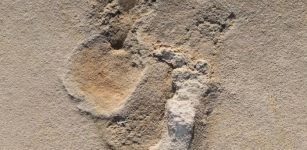Archaeologists Discover Gloucestershire’s Hidden Treasures
Jan Bartek - AncientPages.com - Scientists from Cotswold Archaeology have partnered with National Highways to work on the A417 Missing Link, a joint venture with Oxford Cotswold Archaeology (OCA). Over the past year, they have unveiled exciting discoveries, showcasing the changing landscape and the lives of local inhabitants spanning more than 12,000 years.
The researchers are now helping to reveal thousands of years of Gloucestershire's rich history through their work on the A417 Missing Link project. The £460 million scheme, which commenced in March of the previous year, aims to construct a new dual carriageway on the A417 between Gloucester and Cirencester, replacing an accident-prone section.
Aerial photo of ‘Banjo’ enclosure. Credit: Cotswold Archaeology
The archaeological site has yielded many remarkable artifacts spanning multiple historical periods. Discoveries range from the Mesolithic, Neolithic, Bronze Age, and Iron Age eras to the Roman period and even artifacts from World War II. Among the significant finds are a Roman Cupid figurine, various pottery pieces, coins, and jewelry items. These treasures provide valuable insights into the diverse cultures and civilizations that once thrived in the region.
The National Highways' A417 Missing Link construction project has prompted an extensive archaeological investigation to uncover and preserve the rich history surrounding the old route. Before construction commences, a dedicated team of over 60 archaeologists and 50 office-based specialists have meticulously excavated an area spanning 355,000 square meters. Their efforts have culminated in the discovery and curation of over 10,600 artifacts weighing 100 kilograms. These artifacts, representing the lives and communities that once thrived along the route, will be carefully preserved for future generations to study and appreciate. This comprehensive archaeological endeavor, spanning over 100,000 hours of fieldwork and analysis, ensures that the region's cultural heritage is not lost amidst the upcoming infrastructure development.
"We are excited about the findings this landscape-led scheme is uncovering, as the archaeology team provide a unique window into the ancient history of Gloucestershire. Gloucestershire and the Cotswolds have a rich cultural heritage, and the team are bringing their expertise to bear in adding to that history.
These discoveries will contribute significantly to our understanding of how people in the past adapted to changing environmental conditions, and we will ensure the remains are preserved and recorded. As well as delivering the road upgrade, we’re absolutely committed to conserving and, where possible, enhancing the historic environment and the special landscape around the A417," Steve Foxley, Project Director for the A417 scheme, said in a press release.
Jim Keyte, National Highways' Archaeology Project Manager for the A417, provided insights into the archaeological works in conjunction with the construction project. He stated, "The project is a great example of how well-planned archaeological works can be undertaken successfully without resulting in delays to construction. For over a year, our detailed archaeological excavations have revealed substantial new knowledge about how our ancestors lived and used this landscape. We are now beginning the detailed analysis and interpretation of the finds and we’re looking forward to publishing the results of this work in future."
Early Roman brooch -dating back to 43-80 A.D. Credit: Cotswold Archaeology
According to Alex Thomson, the OCA Project Manager, the archaeologists were aware of the area's archaeological potential, but the findings from their fieldwork have surpassed all expectations. The science team has uncovered remarkable archaeological evidence that unveils a captivating narrative about this region of the Cotswolds spanning thousands of years.
Archaeologists have unearthed an impressive array of artifacts, complementing those discovered during the evaluation stage. These include prehistoric flint tools, pottery from the Neolithic, Bronze Age, Iron Age, and Roman periods, numerous coins and jewelry items, and poignant everyday objects from ancient times, offering a unique glimpse into life across the ages.
During the excavations last summer, they uncovered an Iron Age 'banjo enclosure,' a site that likely served as a hub for significant activities such as feasting. This provided insights into the cultural practices of that era.
See also: More Archaeology News
"An archaeological dig is a really exciting time in a project like this. It’s a privilege for us to work with National Highways and Oxford Cotswold Archaeology to potentially uncover some fascinating artefacts. We look forward to engaging with the local community as we begin to explore this wonderful part of the country,” Gavin Jones, project director at Kier Highways, said.
Written by Jan Bartek - AncientPages.com Staff Writer






















